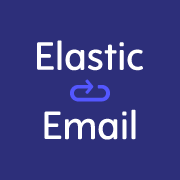In a world where email marketing continues to be a pivotal player in digital strategy, choosing the right tool is more crucial than ever. As 2024 unfolds, businesses are faced with the decision of selecting the best platform to amplify their email campaigns. In this detailed guide, we’re putting Moosend and Elastic Email under the microscope. Both platforms have their merits, but which one will emerge as the best email marketing tool for 2024? Let’s find out, starting with a key area of comparison.
| Moosend | Elastic Email |
|---|---|
 |  |
| G2 Score – 4.6 out of 5 stars | G2 Score – 4.3 out of 5 stars |
| TrustRadius Score – 9.8 out of 10 | TrustRadius Score – 8.0 out of 10 |
User Interface and Ease of Use
In the realm of email marketing, the ease of use and the intuitiveness of the user interface (UI) can greatly impact your productivity and campaign success. Let’s dissect how Moosend and Elastic Email fare in these areas.
Moosend – A Blend of Simplicity and Efficiency
Moosend is celebrated for its straightforward and user-friendly interface. It greets users with a clear and well-organized dashboard, making navigation a breeze even for beginners. This simplicity is a significant advantage, especially for those who are new to email marketing or prefer a no-frills approach to campaign creation.
The platform’s drag-and-drop email editor is a testament to its commitment to user-friendliness. It allows you to create visually appealing emails with ease, no matter your level of technical expertise. Moosend also offers a generous selection of pre-designed templates, which you can customize to suit your brand, saving you time and effort.
Elastic Email – Customization at Your Fingertips
Elastic Email, while also prioritizing user experience, leans more towards offering a customizable UI. It presents a slightly steeper learning curve than Moosend but compensates with more control and flexibility in designing emails. This is ideal for users who have specific requirements or those who enjoy having the freedom to tailor every aspect of their campaigns.
The platform boasts a robust email editor packed with advanced features and customization options. While it might take some time to get the hang of it, the investment in learning pays off with the ability to create unique and sophisticated email designs that can set your campaigns apart from the competition.
User Interface Verdict
When it comes to the user interface and ease of use, the choice between Moosend and Elastic Email depends largely on your preferences and needs. Moosend is the ideal choice if you value simplicity and efficiency. It’s perfect for those who want to quickly set up campaigns without a steep learning curve, making it a great option for small businesses or marketing beginners.
On the other hand, Elastic Email is more suitable for users who are looking for a platform that offers deeper customization options and don’t mind spending some extra time mastering the tool. It’s a good fit for experienced marketers or businesses that require a high level of customization in their email campaigns.
Automation and Workflow Capabilities
A crucial aspect that sets apart top-notch email marketing tools is their automation capabilities. Let’s compare Moosend and Elastic Email in terms of their ability to streamline and automate marketing workflows.
Moosend – Simplified and Powerful Automation
Moosend is recognized for its robust yet straightforward automation features. The platform allows you to create automated email sequences with relative ease, making it a great asset for businesses looking to save time and enhance efficiency.
One of Moosend’s key strengths in automation is its user-friendly approach. The platform provides pre-built automation templates, which are ideal for common email scenarios like welcome series, customer re-engagement, or abandoned cart emails. These templates are not only time-savers but also customizable, allowing for personalization according to specific business needs.
Furthermore, Moosend’s automation extends to subscriber actions and behaviors, enabling you to tailor your communication based on how subscribers interact with your emails. This level of targeting and personalization can significantly increase the effectiveness of your email campaigns.
Elastic Email – Advanced and Customizable Automation
Elastic Email steps up the game with its advanced automation capabilities. It offers a more granular level of control over your email workflows, catering to those who require detailed and complex automation structures.
The platform shines in its ability to let users create intricate automation sequences from scratch. While this requires more effort compared to using pre-built templates, it provides the flexibility to craft highly specific and targeted email journeys. Elastic Email’s automation also integrates seamlessly with other features like segmentation and A/B testing, offering a comprehensive suite of tools for sophisticated email marketing strategies.
Elastic Email’s automation also supports event-triggered emails, allowing for real-time engagement based on subscriber interactions, a feature that can significantly enhance the relevance and timing of your communications.
Automation Comparison
Choosing between Moosend and Elastic Email for automation capabilities depends on your specific needs and the level of complexity you are comfortable managing.
Moosend is ideal for businesses looking for efficient, easy-to-use automation features. It is particularly suited for small to medium-sized businesses or those who are new to email automation and need a balance of simplicity and effectiveness.
Elastic Email, on the other hand, is better suited for businesses that require detailed, customizable automation. Its advanced features cater to marketers who have specific, nuanced needs and the expertise to leverage sophisticated automation tools.
Integration Capabilities
In a world where digital marketing tools need to work in harmony, the integration capabilities of an email marketing platform are crucial. Let’s see how Moosend and Elastic Email stack up in this regard.
Moosend – Extensive Range of Integrations
Moosend excels in its ability to integrate with a wide array of other software and services, making it an excellent choice for businesses using a diverse set of tools. The platform offers seamless integrations with popular CRM systems, eCommerce platforms, and other essential marketing tools. This range of integrations ensures that Moosend can easily fit into your existing digital marketing ecosystem.
The process of integrating these tools with Moosend is typically straightforward, which is a significant advantage for users who may not have extensive technical expertise. Additionally, Moosend’s integration with Zapier opens up the possibility to connect with thousands of other apps, significantly enhancing its versatility.
Elastic Email – Focused and Specialized Integrations
Elastic Email, while offering a narrower range of integrations compared to Moosend, focuses on providing deeper, more specialized connections. These integrations are designed to offer robust data exchange and workflow synchronization, catering to businesses that rely heavily on a few key platforms.
Elastic Email’s API is a standout feature, offering the flexibility for businesses to develop custom integrations. This is particularly valuable for larger organizations or those with unique needs that standard integrations may not satisfy. The ability to create bespoke connections ensures that Elastic Email can be tailored precisely to fit specific operational requirements.
Integration Capabilities: Choosing What Works for You
The decision between Moosend and Elastic Email in terms of integration capabilities will largely depend on the nature of your business’s digital ecosystem. If your business uses a wide variety of tools and you’re looking for an email marketing platform that offers a broad range of integrations with easy setup, Moosend is an excellent choice. Its user-friendly approach to integration makes it ideal for businesses with diverse toolsets. On the other hand, if your business has specific integration needs or requires more in-depth, specialized connections, Elastic Email is the better option. Its API access for custom integrations and focused approach make it suitable for businesses with unique or complex integration requirements.

Related: Check out our free SEO suite

Pricing and Value for Money
In the competitive world of email marketing tools, pricing and the value offered for that price are critical factors. Let’s compare Moosend and Elastic Email in terms of their pricing structures and the overall value they provide.
| Moosend | Free Plan: Offers access to basic features for up to 1,000 subscribers, including email campaigns, automation, and landing pages. Pro Plan: Pricing starts at $8 per month for up to 2,000 subscribers, with unlimited emails. Includes advanced features like transactional emails, landing page builder, and phone support. The price scales with the number of subscribers. Enterprise Plan: Custom pricing for businesses needing custom features like account management, SSO (Single Sign-On), and more. |
| Elastic Email | Unlimited Email Plan: Offers unlimited email sends per month. Pricing starts at $15/month for up to 5,000 contacts, with increasing rates for more contacts. Pay as You Go Plan: Charges based on the volume of emails sent. Starts at $0.09 per 1,000 emails, with the price decreasing for higher volumes. Email API Plan: Tailored for developers and high-volume senders. Offers robust API with detailed reporting. Pricing is based on volume and specific requirements. |
Moosend – Affordable and Scalable
Moosend is often lauded for its affordable pricing model, which makes it an attractive option for small to medium-sized businesses and startups. The platform offers a free plan with essential features, providing an excellent starting point for businesses with limited budgets or those just beginning their email marketing journey.
As your needs grow, Moosend’s pricing scales with your business. The paid plans, based on the number of subscribers, are reasonably priced and offer additional features like advanced segmentation, automation, and landing pages. This scalability ensures that Moosend can support your business’s growth without a sudden surge in costs.
The transparency of Moosend’s pricing structure is another advantage. There are no hidden fees, and the costs are straightforward, allowing for easy budgeting and financial planning.
Elastic Email – Competitive Pricing with Focus on Volume
Elastic Email offers a unique pricing structure that is particularly favorable for businesses with high-volume email needs. The platform’s pricing is based on the number of emails sent rather than the number of subscribers, which can be a cost-effective solution for businesses that frequently communicate with a large audience.
The platform provides a free tier with basic features, which is suitable for small-scale operations or testing the waters. As your email volume increases, Elastic Email’s pricing remains competitive, providing good value for businesses focused on extensive email campaigns.
Moreover, Elastic Email offers pay-as-you-go options, which is ideal for businesses with fluctuating email volumes. This flexibility in pricing ensures that you only pay for what you use, making it a cost-effective solution for many businesses.
Pricing and Value: The Verdict
When it comes to choosing between Moosend and Elastic Email based on pricing and value for money, consider your business’s size, email volume, and growth trajectory. Moosend is an excellent option if you’re looking for an affordable, scalable solution with transparent pricing. Its straightforward cost structure and range of features offer good value, particularly for small to medium-sized businesses. Elastic Email, with its focus on email volume and flexible pricing options, is ideal for businesses that send large volumes of emails. Its competitive pricing for high-volume senders and pay-as-you-go options provide a cost-effective solution for businesses with varying email marketing needs.
Analytics and Reporting
In the world of email marketing, the power lies in understanding your campaign’s performance. Effective analytics and reporting tools are essential for refining strategies and achieving better outcomes. Let’s compare how Moosend and Elastic Email stack up in this crucial area.
Moosend – Comprehensive and User-Friendly Analytics
Moosend offers a robust analytics suite that’s both comprehensive and accessible. The platform provides real-time reporting, allowing you to track key metrics like open rates, click-through rates, and unsubscribe rates as your campaigns unfold. This immediate feedback is crucial for making quick adjustments to enhance campaign performance.
A standout feature of Moosend’s analytics is the clarity and simplicity of the data presentation. The dashboard is designed for ease of understanding, ensuring that even those with minimal analytical experience can quickly grasp their campaign’s performance. This approach is particularly beneficial for small teams or solo marketers who need actionable insights without delving into complex data.
Moreover, Moosend extends its analytics beyond email interactions, tracking user behavior on your website after they click through. This holistic view is invaluable for understanding the broader impact of your email campaigns.
Elastic Email – Advanced Analytics for In-Depth Insights
Elastic Email takes a more detailed approach to analytics, offering a suite of tools for deep data analysis. The platform covers all the standard metrics but goes a step further by providing granular insights into subscriber behavior and detailed campaign performance.
One of Elastic Email’s strengths is its advanced segmentation capabilities within its analytics. You can dissect your campaign performance based on various subscriber segments, allowing for a nuanced understanding of how different groups interact with your emails.
Furthermore, Elastic Email offers tools for A/B testing within its campaigns. This enables you to test different email versions to see which elements resonate best with your audience, a powerful feature for optimizing your email strategy continuously.
Analytics and Reporting: Making the Choice
The decision between Moosend and Elastic Email for analytics and reporting should be based on your specific needs and the level of detail you require. Moosend is an excellent choice if you need a straightforward yet comprehensive analytics platform. Its user-friendly interface and actionable insights make it ideal for those who need quick, digestible data to inform their email strategies. For those who require a more in-depth analytical approach, Elastic Email is the better fit. Its advanced analytics and segmentation capabilities are well-suited for businesses or marketing teams that are data-driven and seek thorough insights to optimize their email campaigns continuously.
Deliverability and Email Performance
A key factor in the success of email marketing campaigns is deliverability – the ability of your emails to successfully land in your audience’s inbox. Let’s evaluate Moosend and Elastic Email in terms of their deliverability and overall email performance.
Moosend – High Deliverability with Strong Infrastructure
Moosend has established a reputation for excellent deliverability rates. This is due to its robust email infrastructure and adherence to best email practices. Ensuring emails reach the inbox and not the spam folder is a priority, and Moosend’s efforts in maintaining a strong sender reputation play a crucial role in this.
The platform also provides tools to optimize email deliverability, including spam testing and domain authentication. These tools help you identify and resolve issues that could impact your email performance, thereby enhancing the likelihood of your emails reaching their intended destination.
Elastic Email – Focused on Optimizing Reach
Elastic Email places a strong emphasis on maximizing email reach and deliverability. The platform utilizes sophisticated algorithms and ongoing monitoring to ensure that your emails have the best chance of not only being delivered but also being noticed by recipients.
One of the standout features of Elastic Email is its commitment to real-time analytics and reporting on deliverability metrics. This includes detailed insights into bounce rates, spam reports, and engagement metrics, allowing you to fine-tune your strategies for optimal performance.
Elastic Email also employs advanced deliverability features, including IP reputation monitoring and detailed feedback loops, ensuring that your email campaigns perform at their best.
Deliverability and Email Performance: The Verdict
When deciding between Moosend and Elastic Email for deliverability and email performance, consider your specific requirements for email campaigns and the level of control you desire over deliverability aspects. Moosend is an excellent choice for those looking for reliable deliverability backed by robust infrastructure and helpful optimization tools. Its user-friendly approach to managing deliverability makes it suitable for a wide range of businesses. Elastic Email, with its detailed deliverability analytics and advanced features, is ideal for those who want in-depth control and insights into their email performance. It’s particularly well-suited for businesses that prioritize email reach and engagement and are willing to dive deep into deliverability analytics.
Conclusion
In the competitive arena of email marketing, selecting the right tool is pivotal for the success of your digital marketing efforts. Our comprehensive analysis of Moosend and Elastic Email has explored various critical aspects, including user interface, automation, integration, pricing, analytics, and deliverability. Moosend stands out for its user-friendly interface, making it an excellent choice for those new to email marketing or who prefer simplicity in their campaign management. Its robust automation capabilities, combined with a scalable pricing model, make it particularly attractive for small to medium-sized businesses looking for an efficient and cost-effective solution.
Elastic Email, on the other hand, shines with its advanced automation features, deep analytical tools, and a focus on email deliverability and performance. The platform is well-suited for businesses that require a high level of customization and control over their email campaigns and are willing to invest in a more sophisticated email marketing strategy. Ultimately, the choice between Moosend and Elastic Email will hinge on your specific needs, the complexity of your email marketing campaigns, and your preference for either simplicity and user-friendliness (Moosend) or advanced features and customization (Elastic Email). Both platforms offer unique strengths, and the best choice is the one that aligns closely with your business goals and marketing strategies in 2024.
Read Next:





















